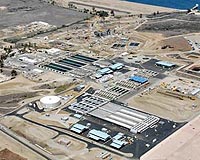 |
Burtonsville MD (SPX) May 27, 2009 New Energy Technologies has announced that the Company is continuing to further advance the development of its tinted transparent glass SolarWindows capable of generating electricity by coating glass surfaces with the world's smallest known organic solar cells. New Energy's SolarWindow technology uses an organic solar array, which achieves transparency through the creative use of conducting polymers which have the same desirable electrical properties as the world's most commercially popular semiconductor, silicon, yet boast a considerably better capacity to 'optically absorb' photons from light and generate electricity. The Company's ultra-small solar cells measure less than � the size of a grain of rice, are fabricated using environmentally-friendly hydrogen-carbon based materials, and successfully produce electricity, as demonstrated in a published peer-reviewed study in the Journal of Renewable and Sustainable Energy of the American Institute of Physics. "Our use of these new, readily available and easy-to-apply ultra-small solar cells marks an important advance over the early research and development of our transparent photovoltaic SolarWindow technology, and directly addresses numerous commercial and technical limitations posed by conventional materials, including thin films, polycrystalline solar cells, and silicon," stated Mr. Meetesh V. Patel, Esq., President and CEO of New Energy Technologies, Inc. "I'm particularly impressed by the potential application of this technology in areas where direct exposure to sunlight is limited or unavailable, since these ultra-small solar cells have demonstrated a special ability to generate electricity in both natural and artificial light conditions." Unlike other solar technologies, New Energy's ultra-small solar cells generate electricity not only from the visible light spectrum found in sunlight but also by using the visible light found in artificial light, such as fluorescent lighting typically installed in offices and commercial buildings. Commercially, while the majority of today's solar cells can only be installed where direct sunlight is available, New Energy's ultra-small solar cells can be installed anywhere that direct sunlight or artificial lighting such as fluorescent systems emit visible light.
Ultra-Small Solar Cells: Generating Electricity on Transparent Glass Currently available solar cells are largely made of silicon wafers, an expensive and brittle material that can limit their commercial usability. Other newer generation, lower cost flexible thin film solar materials such as amorphous silicon, copper-indium-gallium-selenide, and cadmium telluride often require high-vacuum and high-temperature production techniques, and are many times thicker than New Energy's ultra-small solar cells. This generally limits the application of such thin films primarily to stainless steel, an expensive substrate material with limited prospects of delivering transparency. The superior optical absorption properties of New Energy's ultra-small solar cells enables development of an ultra-thin film, only 1/1000th the thickness of a human hair, or 1/10th of a micrometer. Conventional thin films are exponentially thicker, measuring several micrometers thick and inhibiting transparency. In photovoltaic applications such as see-thru windows, where transparency is a primary concern, today's thin film solar cells simply cannot be utilized to produce a transparent solar window for application in homes, offices, and commercial buildings. There are nearly 5 million commercial buildings in America, according to the Energy Information Administration, and more than 80 million single detached homes. Share This Article With Planet Earth
Related Links New Energy Technologies All About Solar Energy at SolarDaily.com
 Metropolitan Begins Generating Solar Power At Skinner Plant
Metropolitan Begins Generating Solar Power At Skinner PlantTemecula CA (SPX) May 26, 2009 With a literal flip of a switch, the Metropolitan Water District of Southern California added to its investments in solar power. Metropolitan board Chairman Timothy F. Brick flipped a switch signifying activation of a 10-acre field of solar panels at the district's Robert A. Skinner Water Treatment Plant in the Temecula Valley of southwestern Riverside County. The 1-megawatt solar installa ... read more |
|
| The content herein, unless otherwise known to be public domain, are Copyright 1995-2009 - SpaceDaily. AFP and UPI Wire Stories are copyright Agence France-Presse and United Press International. ESA Portal Reports are copyright European Space Agency. All NASA sourced material is public domain. Additional copyrights may apply in whole or part to other bona fide parties. Advertising does not imply endorsement,agreement or approval of any opinions, statements or information provided by SpaceDaily on any Web page published or hosted by SpaceDaily. Privacy Statement |